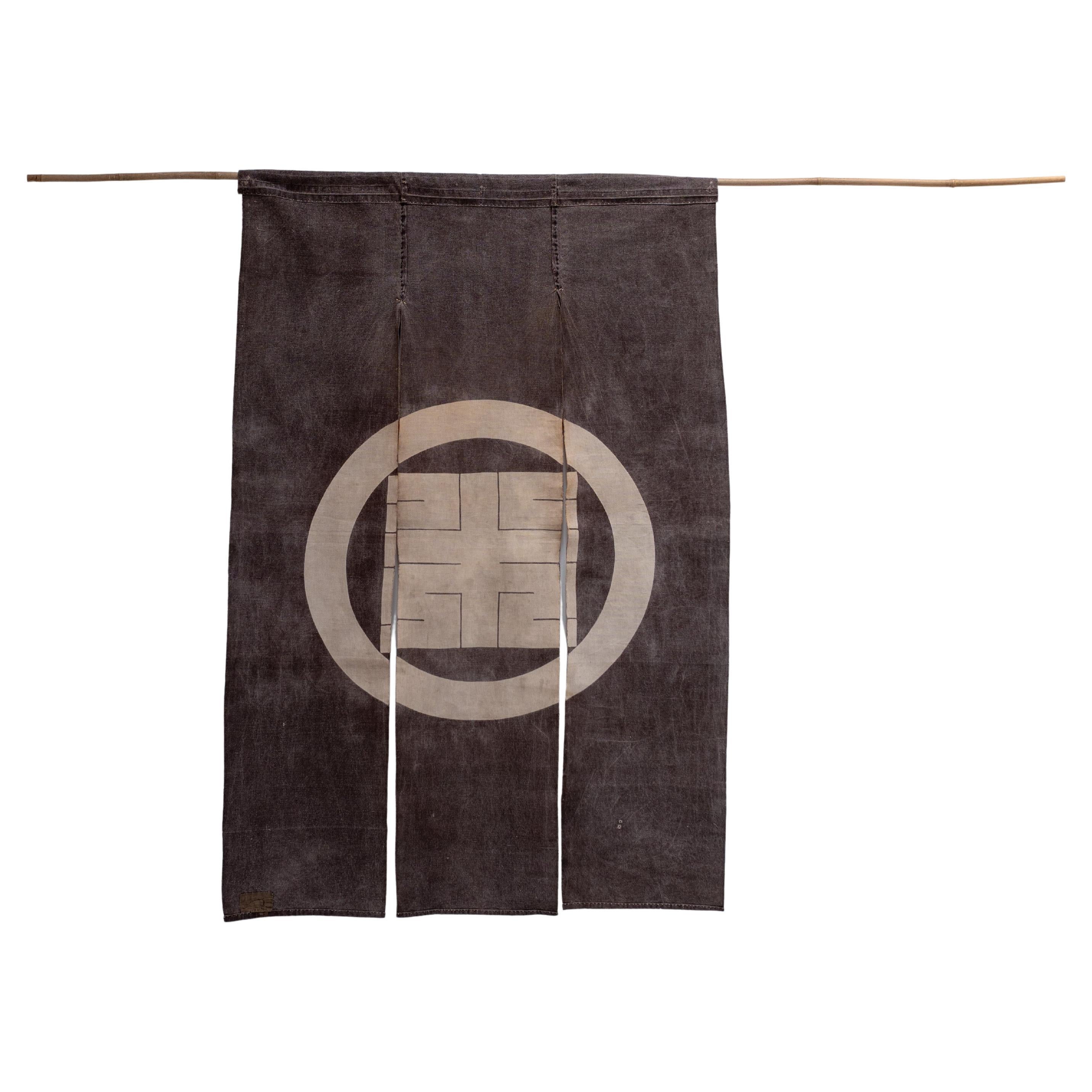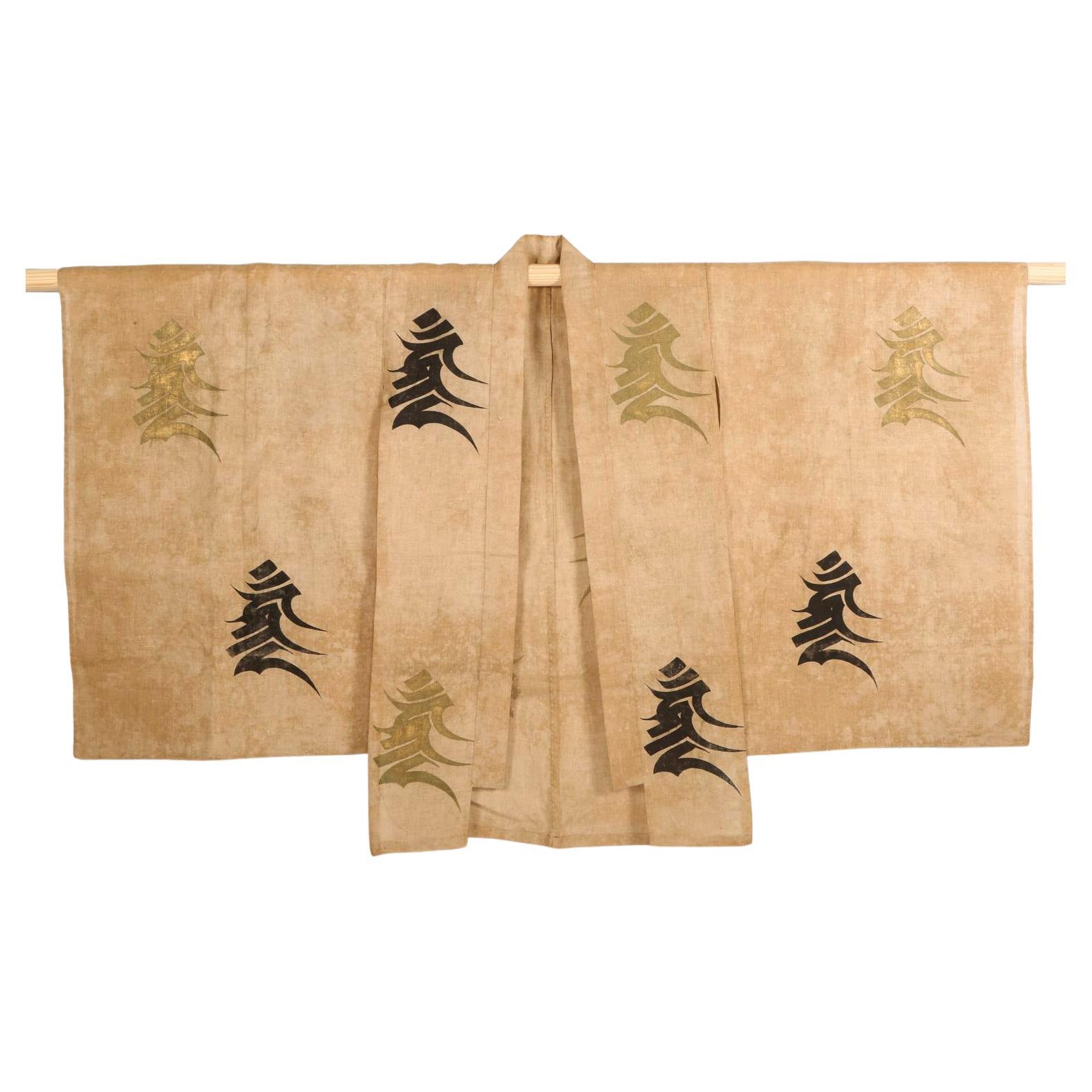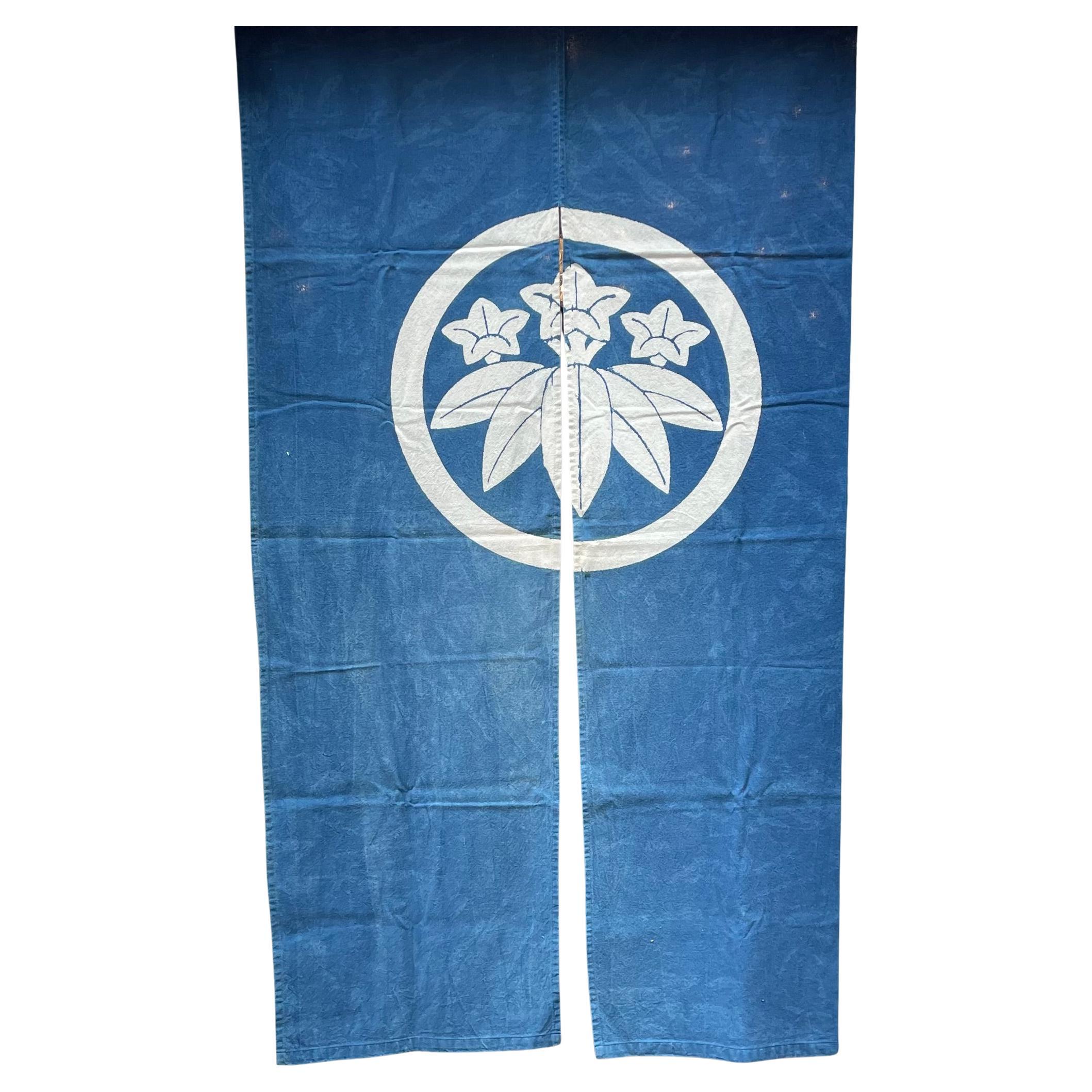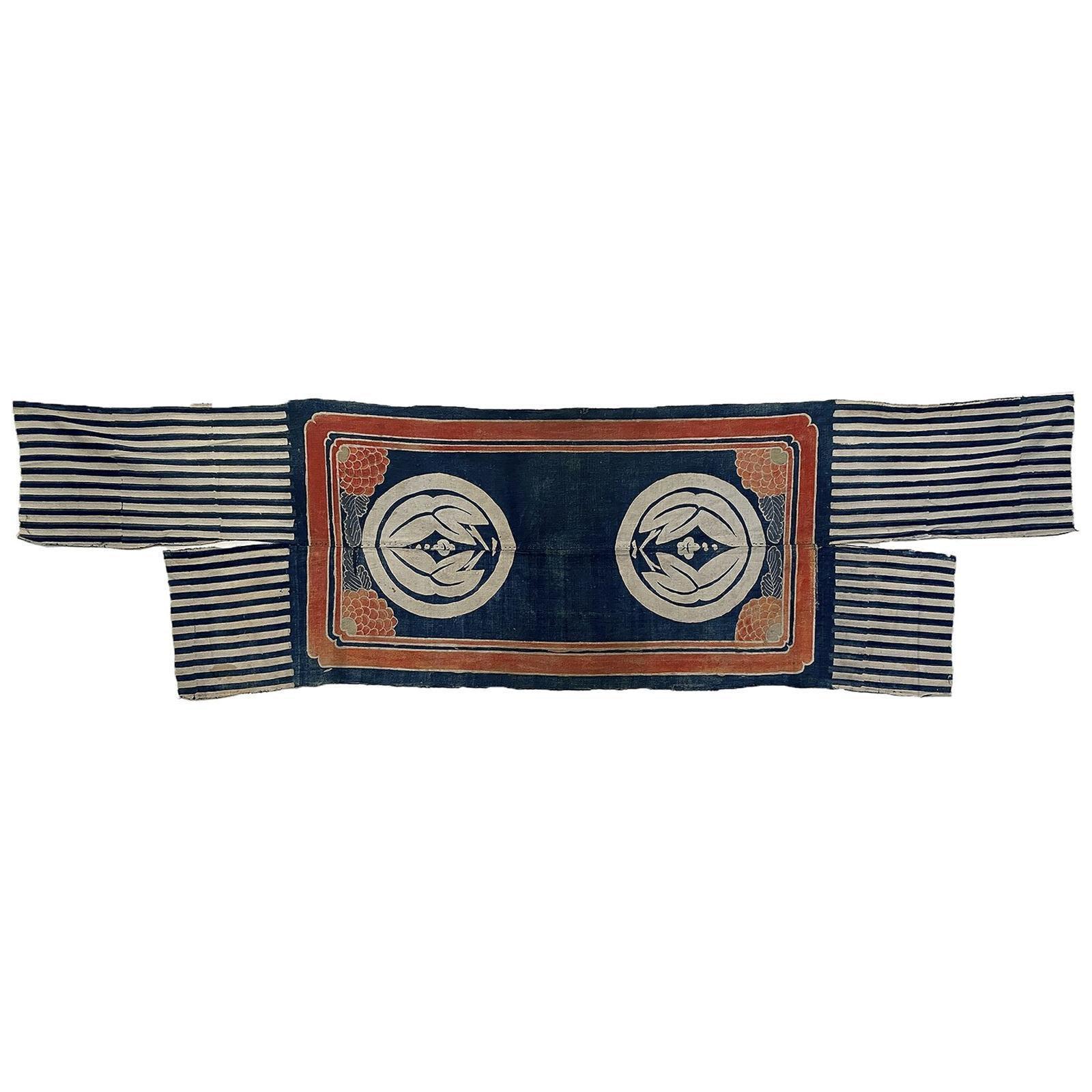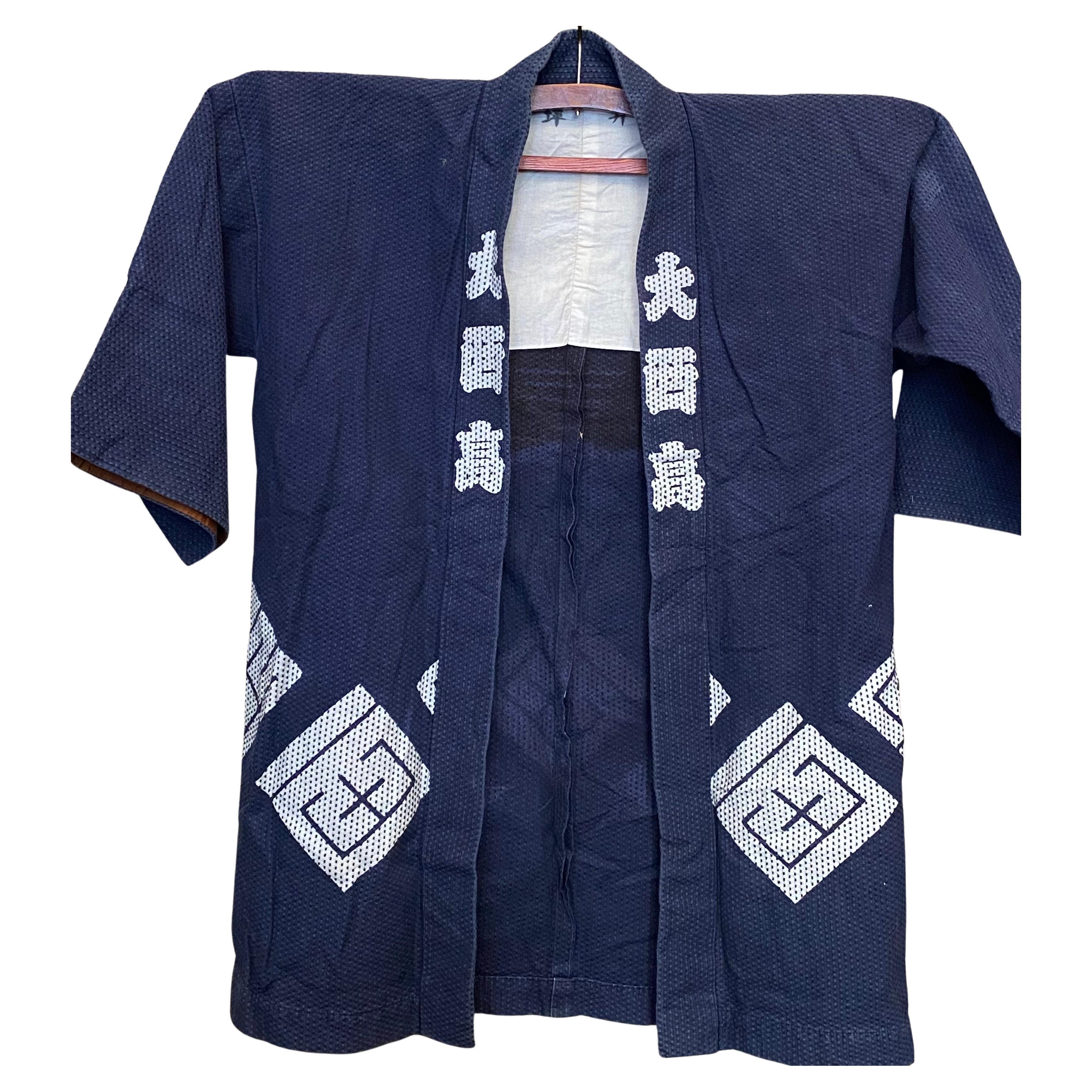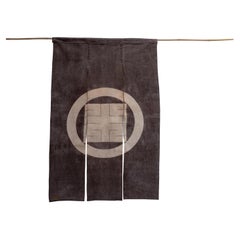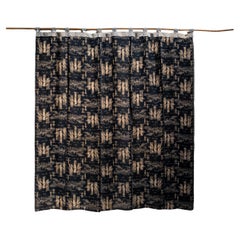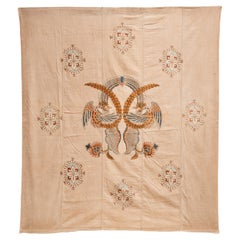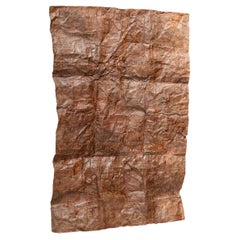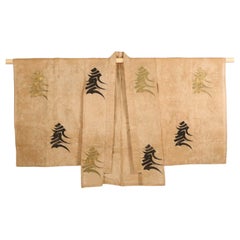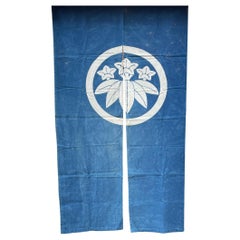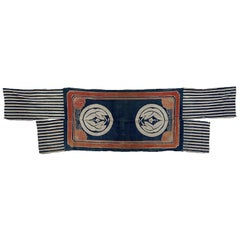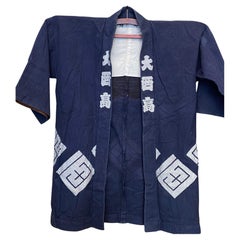Items Similar to Divider, Tsutsugaki Aigaeshi-Dyed Noren with Family Crest, Japan, 19th Century
Want more images or videos?
Request additional images or videos from the seller
1 of 15
Divider, Tsutsugaki Aigaeshi-Dyed Noren with Family Crest, Japan, 19th Century
$1,200
£906.97
€1,045.32
CA$1,693.20
A$1,866.02
CHF 976.93
MX$22,920.68
NOK 12,275.29
SEK 11,488.69
DKK 7,804.76
About the Item
This is a traditional Japanese noren (fabric divider) from the late Edo period, created in Yamagata Prefecture in the 19th century. Crafted from hand-spun and hand-woven hemp, it features the elaborate tsutsugaki aigaeshi dyeing technique—a specialized form of indigo reversal resist-dyeing prized for its bold contrast and precision.
The design includes the “Five-Boned Fan Crest” (Gohon-hone Ōgi-mon), a motif symbolizing the summoning of deities or spirits, reflecting its cultural role in military command as well as ceremonial contexts.
Such hemp noren from approximately 150 years ago are exceptionally rare, particularly those showcasing this level of craftsmanship and preservation. Despite visible signs of age, including small holes and frayed loops, the textile remains in usable condition and offers significant historical and artistic value.
Perfect as a striking wall hanging, room divider, or cultural accent in interiors. Adds a sophisticated, authentic Japanese touch to homes, boutiques, tea rooms, or gallery spaces. Offers both historical depth and decorative beauty, making it ideal for collectors and designers seeking unique heritage textiles.
- Dimensions:Height: 63.39 in (161 cm)Width: 37.01 in (94 cm)Depth: 0.4 in (1 cm)
- Materials and Techniques:
- Place of Origin:
- Period:
- Date of Manufacture:19th Century
- Condition:Minor losses.
- Seller Location:Tokyo, JP
- Reference Number:1stDibs: LU2614345851892
About the Seller
5.0
Vetted Professional Seller
Every seller passes strict standards for authenticity and reliability
Established in 2008
1stDibs seller since 2017
132 sales on 1stDibs
Typical response time: 8 hours
- ShippingRetrieving quote...Shipping from: Tokyo, Japan
- Return Policy
Authenticity Guarantee
In the unlikely event there’s an issue with an item’s authenticity, contact us within 1 year for a full refund. DetailsMoney-Back Guarantee
If your item is not as described, is damaged in transit, or does not arrive, contact us within 7 days for a full refund. Details24-Hour Cancellation
You have a 24-hour grace period in which to reconsider your purchase, with no questions asked.Vetted Professional Sellers
Our world-class sellers must adhere to strict standards for service and quality, maintaining the integrity of our listings.Price-Match Guarantee
If you find that a seller listed the same item for a lower price elsewhere, we’ll match it.Trusted Global Delivery
Our best-in-class carrier network provides specialized shipping options worldwide, including custom delivery.More From This Seller
View AllFabric Divider, Cotton Noren with Kakumoji Character, Japan, Early 20th Century
Located in Tokyo, Tokyo
This is a traditional Japanese noren (fabric shop curtain) dating to the Taisho period (1912–1926), crafted from cotton dyed with persimmon tannin (kaki...
Category
Early 20th Century Japanese Textiles
Materials
Cotton
Japanese Vintage Linen Noren, Textile, Wabi Sabi, 19th Century
Located in Tokyo, Tokyo
The unique and beautiful fabric piece, that's called noren - traditional Japanese fabric divider that was made during the Meiji era. This traditional Japanese curtains used to divide...
Category
Antique 19th Century Japanese Textiles
Materials
Linen
Japanese Vintage Fabric, Wabi Sabi, 1910s
Located in Tokyo, Tokyo
This unique and elegant textile with a phoenix pattern, known as Nagasaki Sarasa, was made in Nagasaki Prefecture (Kyushu) during the Taisho era.
The fabric was likely intended fo...
Category
Vintage 1910s Japanese Textiles
Materials
Cotton
Japanese Persimmon-Dyed Washi Curtain (Shichou-maku), 19th Century
Located in Tokyo, Tokyo
This striking “shichou-maku,” or paper curtain, dates to the Meiji period and was originally used in sericulture rooms to shield silkworms from drafts and cold air. Hung from ceiling...
Category
Antique 19th Century Japanese Textiles
Materials
Paper
Japanese Persimmon-Dyed Washi Rug with Layered Repairs, 20th Century
Located in Tokyo, Tokyo
This rare persimmon tannin–dyed washi rug dates from the late Meiji to Taisho period (early 20th century) and was traditionally used to protect tatami mats from sunlight or serve as ...
Category
20th Century Japanese Textiles
Materials
Paper
"Usu", Hande-carved, Wabi-sabi, Early 20th Century, Japan
Located in Tokyo, Tokyo
"Usu" is one of the traditional tools with a rich history, representing an important aspect of Japanese culture, especially in culinary arts. Typically, it consists of a large wooden...
Category
Early 20th Century Japanese Folk Art Antiquities
Materials
Wood
You May Also Like
Antique Japanese Noh Outer Cloak Chōken with Stencil Decoration
Located in Atlanta, GA
A large and striking Japanese outer cloak for Noh performance (known as Choken) circa 19th century (late Edo to early Meiji period). The robe was woven from a natural bast-fiber (kno...
Category
Antique 19th Century Japanese Edo Textiles
Materials
Natural Fiber
Japanese Cotton Curtains Noren Maruni Sasarindo 1960s
Located in Paris, FR
This is a Japanese curtain which was made in Japan around 1960s.
It is called Noren. This noren has a family crest (kamon) in the middle. This type of Kamon is called Maruni Sasa Rindo.
This noren is with cotton and starts losing a color because of sun but it is in good condition for its age. The color is beautiful.
Noren:
Noren are fabric dividers hung in doorways, across windows, on walls or between rooms. They take many shapes and sizes and are made using a multitude of different colors, patterns and materials.
Traditional noren are hand-woven using natural fabrics like linen and cotton and often dyed with natural dyes like Japanese indigo.
Maruni sasa rindo:
"Maru ni Sasa Rindo" is a Japanese family crest...
Category
Vintage 1960s Japanese Showa Tapestries
Materials
Cotton
Japanese Horse Trapping, "Uma-No-Haragake", Tsutsugaki, Cotton, Meiji Period
Located in Point Richmond, CA
Japanese horse trapping, "Uma-No-Haragake", Tsutsugaki, cotton, Meiji period
This type of haragake is called yuiage ("tied up"). The central portion covered the belly of the horse an...
Category
20th Century Japanese Meiji Textiles
Materials
Cotton
Japanese Antique Hanten "Onishiko" with Cotton showa (around 1960s)
Located in Paris, FR
Hanten is a type of traditional Japanese garment that is often referred to as a "short coat" or "jacket". `it has a loose, kimono-like design with a straight collar and is typically ...
Category
Vintage 1960s Japanese Antiquities
Materials
Cotton
Japanese Woven Linen Kimono with Katazome Stencil Dyes
Located in Atlanta, GA
On offer is a Japanese summer kimono woven from indigo blue linen with ivory color fine stripes patterns with apparently darker weft additions. The elega...
Category
Early 20th Century Japanese Japonisme Textiles
Materials
Linen
Antique Japanese Stencil-Dyed Han-Juban With Fan Motif
Located in Point Richmond, CA
Antique Japanese Stencil-Dyed Han-Juban With Fan Motif
Han-juban are short, waist length garments that are worn under kimono. It’s not uncommon for older examples to be missing thei...
Category
Early 20th Century Japanese Taisho Tribal Art
Materials
Cotton
More Ways To Browse
19th Century Fabric
Japanese Fabric Art
Antique Fabrics And Textiles Fabric Textiles
Japanese Fan Art
Family Crests
Antique Family Crest
Japanese Wall Fabric
Antique Hemp
Japanese Indigo Textile
Indigo Wall Hanging
Japanese Noren
Antique Noren
Antique Chinese Robe
Brocade Kimono
Ikat Textile From Sumba
Indonesia Horse
Japanese Futon
Framed Japanese Textiles
